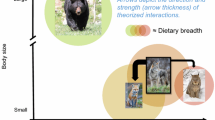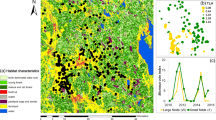Abstract
General mechanisms underlying the distribution and fitness of synanthropic predators in human-influenced landscapes remain unclear. Under the consumer resource-matching hypothesis, synanthropes are expected to distribute themselves among habitats according to resource availability, such that densities are greater in human-subsidized habitats, but mean individual fitness is equal among habitats because of negative density dependence. However, “under-matching” to human food resources can occur, because dominant individuals exclude subordinates from subsidized habitats and realize relatively high fitness. We integrated physiological, behavioral, and demographic information to test resource-matching hypotheses in Steller’s jays (Cyanocitta stelleri), a synanthropic nest predator, to understand how behavior and social systems can influence how synanthropes respond to food subsidies. Jays consumed more human foods at subsidized (park campground) sites than jays at unsubsidized (interior forest) sites based on stable isotope analyses. Jays that occurred at higher densities were in better body condition (based on feather growth bars and lipid analyses), and had greater reproductive output at subsidized than unsubsidized sites. Jays with breeding territories in subsidized sites maintained relatively small home ranges that overlapped with multiple conspecifics, and exhibited a social system where dominant individuals typically won contests over food. Thus, jays appeared to be under-matched to prevalent resource subsidies despite high densities and behaviors expected to lead to resource matching. Our results also indicate that local resource subsidies within protected areas can result in source habitats for synanthropes, potentially impacting sensitive species over broader spatial scales.





Similar content being viewed by others
References
Bearhop S, Waldron S, Votier SC, Furness RW (2002) Factors that influence assimilation rates and fractionation of nitrogen and carbon stable isotopes in avian blood and feathers. Physiol Biochem Zool 75:451–458
Beckmann JP, Berger J (2003) Using black bears to test ideal-free distribution models experimentally. J Mammal 84:594–606
Beyer HL (2012) Geospatial Modelling Environment (version 0.7.3.0) (software). http://www.spatialecology.com/gme. Accessed 9 Mar 2016
Brown JL (1963) Aggressiveness, dominance and social organization in the Steller Jay. Condor 65:460–484
Buehler DA, Fraser JD, Fuller MR et al (1995) Captive and field-tested radio transmitter attachments for bald eagles. J Field Ornithol 66:173–180
Calenge C (2006) The package “adehabitat” for the R software: a tool for the analysis of space and habitat use by animals. Ecol Model 197:516–519
Cornell HN, Marzluff JM, Pecoraro S (2012) Social learning spreads knowledge about dangerous humans among American crows. Proc R Soc Lond B Biol Sci 279:499–508
Duhem C, Roche P, Vidal E, Tatoni T (2008) Effects of anthropogenic food resources on yellow-legged gull colony size on Mediterranean islands. Popul Ecol 50:91–100
Emery NJ, Seed AM, von Bayern AMP, Clayton NS (2007) Cognitive adaptations of social bonding in birds. Philos Trans R Soc B Biol Sci 362:489–505
Evans BS, Ryder TB, Reitsma R et al (2015) Characterizing avian survival along a rural-to-urban land use gradient. Ecology 96:1631–1640. doi:10.1890/14-0171.1
Fagen R (1987) A generalized habitat matching rule. Evol Ecol 1:5–10
Fedriani JM, Fuller TK, Sauvajot RM (2001) Does availability of anthropogenic food enhance densities of omnivorous mammals? An example with coyotes in southern California. Ecography 24:325–331
Fieberg J, Kochanny CO (2005) Quantifying home-range overlap: the importance of the utilization distribution. J Wildl Manag 69:1346–1359
Fretwell SD (1972) Populations in a seasonal environment. Princeton University Press, Princeton
Fretwell SD, Lucas JS (1970) On territorial behavior and other factors influencing habitat distribution in birds. Theor Dev Acta Biotheor 19:16–36
Gitzen RA, Millspaugh JJ, Kernohan BJ (2006) Bandwidth selection for fixed-kernel analysis of animal utilization distributions. J Wildl Manag 70:1334–1344
Griffiths R, Double MC, Orr K, Dawson RJG (1998) A DNA test to sex most birds. Mol Ecol 7:1071–1075
Grubb JTC (2006) Ptilochronology: feather time and the biology of birds. Oxford University Press, Oxford
Haché S, Villard M-A, Bayne EM (2013) Experimental evidence for an ideal free distribution in a breeding population of a territorial songbird. Ecology 94:861–869
Hopkins JB, Koch PL, Ferguson JM, Kalinowski ST (2014) The changing anthropogenic diets of American black bears over the past century in Yosemite National Park. Front Ecol Environ 12:107–114
Horak P, Lebreton J-D (1998) Survival of adult Great Tits Parus major in relation to sex and habitat; a comparison of urban and rural populations. Ibis 140:205–209
Johnston RF (2001) Synanthropic birds of North America. In: Marzluff JM, Bowman R, Donnelly R (eds) Avian ecology and conservation in an urbanizing world. Kluwer Academic Publishers, Boston, pp 49–67
Kennedy M, Gray RD (1993) Can ecological theory predict the distribution of foraging animals? A critical analysis of experiments on the ideal free distribution. Oikos 68:158–166
Kernohan BJ, Gitzen RA, Millspaugh JJ (2001) Analysis of animal space use and movements. In: Marzluff JM, Millspaugh JJ (eds) Radio tracking and animal populations. Academic Press, San Diego, pp 125–166
Loss SR, Will T, Loss SS, Marra PP (2014) Bird–building collisions in the United States: estimates of annual mortality and species vulnerability. Condor 116:8–23. doi:10.1650/CONDOR-13-090.1
Luginbuhl JM, Marzluff JM, Bradley JE et al (2001) Corvid survey techniques and the relationship between corvid relative abundance and nest predation. J Field Ornithol 72:556–572
Marzluff JM, Neatherlin E (2006) Corvid response to human settlements and campgrounds: causes, consequences, and challenges for conservation. Biol Conserv 130:301–314
McGowan KJ (2001) Demographic and behavioral comparisons of suburban and rural American Crows. In: Marzluff JM, Bowman R, Donnelly R (eds) Avian ecology and conservation in an urbanizing world. Kluwer Academic Publishers, Norwell, MA
Newsome SD, Garbe HM, Wilson EC, Gehrt SD (2015) Individual variation in anthropogenic resource use in an urban carnivore. Oecologia 178(1):115–128
Pearson SF, Levey DJ, Greenberg CH, del Rio CM (2003) Effects of elemental composition on the incorporation of dietary nitrogen and carbon isotopic signatures in an omnivorous songbird. Oecologia 135:516–523
Peery MZ, Beissinger SR, Newman SH et al (2004) Applying the declining population paradigm: diagnosing causes of poor reproduction in the marbled murrelet. Conserv Biol 18:1088–1098. doi:10.1111/j.1523-1739.2004.00134.x
Peery MZ, Becker BH, Beissinger SR, Burger AE (2007) Age ratios as estimators of productivity: testing assumptions on a threatened seabird, the marbled murrelet (Brachyramphus marmoratus). Auk 124:224–240
Powell LA (2007) Approximating variance of demographic parameters using the delta method: a reference for avian biologists. The Condor 109:949–954
Pyle P, Howell SNG, Yunick RP, DeSante DF (1997) Identification guide to North American passerines. Slate Creek Press, Bolinas, California
R Development Core Team (2014) R: a language and environment for statistical computing. R Foundation for Statistical Computing
Ralph CJ, Droege S, Sauer JR (1995) Managing and monitoring birds using point counts: Standards and applications. U.S. Forest Service, Pacific Southwest Research Station, Albany, California
Ridley J, Komdeaur J, Sutherland W (2004) Incorporating territory compression into population models. Oikos 105:101–108
Rodewald AD, Shustack DP (2008) Consumer resource matching in urbanizing landscapes: are synanthropic species over-matching. Ecology 89:515–521
Sauer JR, Hines JE, Fallon JE, et al (2014) Breeding Bird Survey Summary and Analysis 1966–2013. Version 01.30.2015. In: USGS Patuxent Wildl. Res. Cent. Laurel MD. http://www.mbr-pwrc.usgs.gov/bbs/bbs.html. Accessed 28 May 2015
Shochat E (2004) Credit or debit? Resource input changes population dynamics of city-slicker birds. Oikos 106:622–626
Shochat E, Warren P, Faeth S et al (2006) From patterns to emerging processes in mechanistic urban ecology. Trends Ecol Evol 21:186–191. doi:10.1016/j.tree.2005.11.019
Sibly RM, Jones PJ, Houston DC (1987) The use of body dimensions of lesser black-backed gulls larus fuscus to indicate size and to estimate body reserves. Funct Ecol 1:275–279
Sih A, Ferrari MCO, Harris DJ (2011) Evolution and behavioural responses to human-induced rapid environmental change. Evol Appl 4:367–387
Swihart RK, Slade NA (1985) Testing for independence of observations in animal movements. Ecology 66(4):1176–1184
Thomas L, Laake JL, Strindberg S et al (2004) Distance 4.1 Release 2. Research unit for wildlife population assessment. (online)
Vigallon SM, Marzluff JM (2005) Is nest predation by Steller’s jays (Cyanocitta stelleri) incidental or the result of a specialized search strategy? Auk 122:36–49
Walker LE, Marzluff JM (2015) Recreation changes the use of a wild landscape by corvids. Condor 117:262–283
Webb WC, Marzluff JM, Hepinstall-Cymerman J (2011) Linking resource use with demography in a synanthropic population of common ravens. Bio Conserv 144(9):2264–2273
West EH, Henry WR, Goldenberg W, Peery MZ (2016) Influence of food subsidies on the foraging ecology of a synanthropic species in protected areas. Ecosphere 7(10):e01532
Acknowledgements
Funding was provided by Save the Redwoods League, the College of Agriculture and Life Sciences (UW-Madison), the Department of Forest and Wildlife Ecology (UW-Madison), the Office of the Vice Chancellor for Research and Graduate Education (UW-Madison), the U.S. Fish and Wildlife Service, and the California Department of Fish and Wildlife. We thank numerous field and laboratory technicians for their dedicated efforts and California State Parks staff for logistical assistance.
Author information
Authors and Affiliations
Contributions
EHW and MZP conceived the idea, design, and experiment. EHW performed the experiment. EHW and MZP analyzed the data and wrote the manuscript.
Corresponding author
Ethics declarations
Conflict of interest
The authors declare that they have no conflict of interest.
Animal ethics
All applicable institutional and national guidelines for the care and use of animals were followed. The research was conducted under animal ethics permit A01424-0-01-10 and scientific collection permit SC-011200.
Data availability
The data sets analyzed during the current study are available from the corresponding author on reasonable request.
Additional information
Communicated by Hannu J. Ylonen.
Electronic supplementary material
Below is the link to the electronic supplementary material.
Rights and permissions
About this article
Cite this article
West, E.H., Peery, M.Z. Behavioral mechanisms leading to improved fitness in a subsidized predator. Oecologia 184, 787–798 (2017). https://doi.org/10.1007/s00442-017-3898-0
Received:
Accepted:
Published:
Issue Date:
DOI: https://doi.org/10.1007/s00442-017-3898-0




